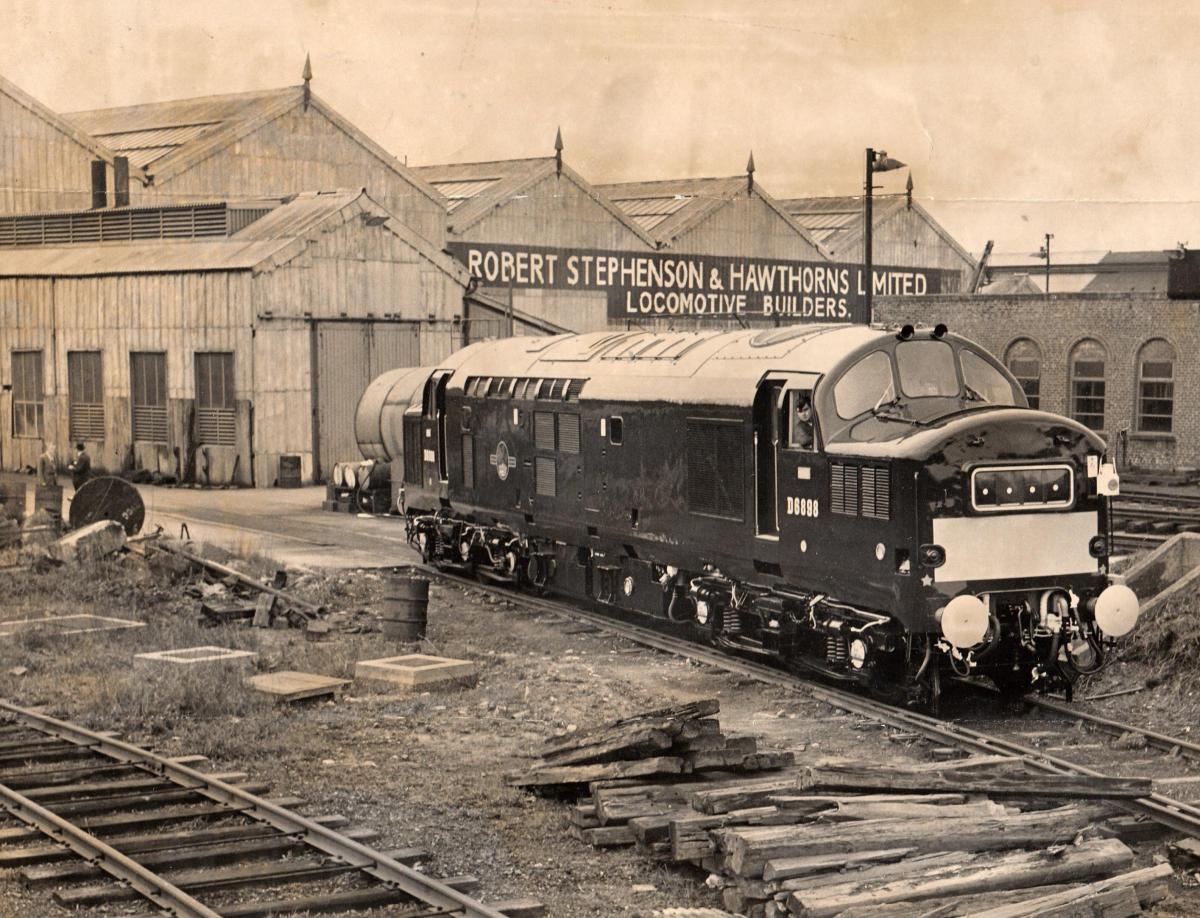Volunteers have rediscovered the Rockwell, a curious composition of stones and water unique in the Darlington area which was once the home of fairies and wee savages
TO some, the Rockwell was a mystical place, its cool, clear water spouting out of a small cave in which little fairy people once lived. To others, it was an abomination of nature that needed to be concreted over.
“Quite frankly, this stream is filthy and smelly,” boomed John Rennie, the manager of Bovis Homes which in 1976 wanted to build on top of it. “It would be better piped. I wouldn’t expect anyone to want to have it running through their garden.”
The Rockwell is beside the Skerne in Darlington, almost in the shadow of the Five Arches Bridge which carries the East Coast Mainline over the river. It is on the edge of the village of Haughton and it was once at the foot of Robert Stephenson & Company’s enormous locomotive works, established in 1900 and from 1955 to 1983 occupied by Phoenix Tubeman.
“Stivvies” regarded the Rockwell as interesting curio on the edge of its estate, but as housing crept over the factory site in the 1970s and 1980s, developers regarded it as an irritation. Although it was saved from a fate worse than concrete, houses were built right up to its edge and its water was spirited away down an unromantic concrete culvert.
Local residents, led by David Race, fought to establish a nature reserve around it in the mid-1980s, but since then, the strange pile of stones became forgotten and overgrown.
But before Christmas, a new generation of residents led by Alan Harrison and Alan Craig started edging the riverside paths, and then they were drawn in to clear away the ivy, brambles and saplings and reveal the Rockwell in all its – rather ugly, if we’re honest – glory.
It looks like a heap of old concrete.
Various little stones have been compacted together to create the rough rock from which the water springs.
Some geologists have referred to it as being “breccia” – an Italian word for broken stone, or gravel. Others call it a “glacial conglomerate” – little stones crushed together by the power of a glacier.
Or there is a theory that many millions of years ago when this area was desert, it was a rocky outcrop that sandstorms eroded to give it its rough face.
Everyone agrees it is unique. There is nothing like it for miles around.
Darlington’s most eminent rock-lover was Dr Richard Taylor Manson, founder of the Darlington & Teesdale Field Naturalists Club and a 19th Century columnist for decades in the Darlington & Stockton Times. The Manson Monument – a large Ice Age boulder – that greets visitors to the Victoria Embankment entrance of South Park was dragged out of the Tees at Winston and dropped in the park as a memorial to him in 1901 shortly after his death.
Dr Manson doesn’t look like someone who deals in fancies. He looks like someone who deals in rock hard facts.
So it is a surprise that the first chapter in his 1898 book, The Zig Zag Ramblings of a Naturalist, is a long discussion about the origin of the fairy stories that are attached to the Rockwell. For generations, he said, the Rockwell had been known as the home of “harmless little beings seen only in the evenings which vanished mysteriously when rudely addressed”.
The origin of these stories, he said, was that once upon a time, a long, long time ago, a race of dwarf cavemen lived beneath the Rockwell.
“These wee savages armed themselves with bows and arrows tipped with flint,” he wrote. “They drank many a time from this very Rockwell for they certainly lived about here. I have seen scores of their little arrowheads and I dare say some hundreds have been found at Newton Ketton, near Brafferton.
“They were a timid race and lived in caves and got their precarious living as best they could.”
Dr Taylor even drew pictures of flint arrowheads that had been found in the Darlington area. Local superstition said claimed that they had been fired by fairies, but Dr Taylor believed they belonged to the pygmy people of Rockwell.
Dr Taylor was writing when the naturalist world was agog at the discovery of the Moking Hurth Cave, near Langdon Beck, in Upper Teesdale. It is also known as Backhouse Cave, Malkins Cave or Teesdale Cave. It had been explored in the 1870s and 1880s by James Backhouse of York, a famous naturalist related to the Darlington Quaker banking family. He had found all manner of animal bones – mainly sheep and wild pigs, but also wolf and possibly lynx) – plus a small decapitated female human skeleton.
Scientists said that she had been a prehistoric cave-dweller, but local legend connected her to fairies and witches, which is why the cave was also known as Malkins Cave – a malkin was a folklore name for a witch’s cat, as used by Shakespeare in the famous scene at the beginning of Macbeth.
These recent discoveries were on Dr Taylor’s mind as he wrote about Rockwell, and the clincher must have been that, just as at Rockwell, a spring gushed out from beneath Moking Hurth Cave.
Whether you believe in fairies or not, Rockwell has long held a fascination for Darlington people. Before Stephenson’s locomotive works came, Rockwell was on a popular footpath from North Road, under the Five Arches Bridge, along the banks of the meandering Skerne to Haughton.
The historian WH Longstaffe, writing in 1854, said: “This, with its canopy of trees, is a beautiful little scene, but it has been much injured in latter years by a wholesale plunder of part of the rock, to the great regret of all lovers of nature’s elegance.”
This theme was repeated by JD Sinclair in his 1949 book, Those Boys o’Bondgate: “The charming little nook of Rockwell which has ever cool waters protected by an overhanging mass of conglomerate rock. It is very regrettable that no attempt has ever been made to protect this really interesting spot.”
And so in the 1970s, Bovis Homes planned to concrete over Rockwell but a council architect, John Burroughs, fought a rearguard action.
In the early 1980s, Darlington council planned to demolish the derelict locomotive works and tip as much of the debris as possible in to Rockwell’s nook. It was back then an unloved corner of town, and a gas main and a main sewer were laid along the riverbank at a depth of 15ft, irreversibly altering the ecology and drainage of the area.
But resident David Race led a rearguard action and helped create a nature reserve, which is now looked after by the Friends of Rockwell (find them on Facebook). Two of the Friends have now rediscovered the Rockwell.
“There has been some brilliant work by the two Alans and we can see once again what a tremendous feature it is and what an asset it could be for the future,” said local councillor, Nick Wallis. “We will be working with the Friends and local people, and hopefully with the Brightwater project, to see what the future holds for this important and unique part of the natural history of the Darlington area.”
Anyone who would like to help in the rediscovery of Rockwell can get in touch with the Friends via Facebook or call 07960-247554. We’d love to hear any memories or see any photos of Rockwell. Please email chris.lloyd@nne.co.uk
THIS was a watery part of the world. To the north of Rockwell is the Springfield pub, and before the homes were built in the 1970s, there was a spring in a field beside the locomotive works. It fed a pond and then ran 150 yards south as Little Beck to Rockwell, from where it joined the Skerne. Little Beck was piped away beneath the houses of Martindale Road, Inglewood Close and Littlebeck Drive.
On the south bank of the Skerne almost opposite Rockwell, another spring gushed forth from the bank on which the Albert Hill Industrial Estate now stands. It was called Dropwell, and it filled two deep pools that up to the 1930s were popular for swimming – even though they were known as “the blue pools” because of their algae bloom.
The blue pools seem to have disappeared when the Skerne was straightened to prevent it from flooding.
FAIRY sightings are nearly always connected to watery, marshy areas where, in the past, mists would suddenly rise up and in which all sorts of half-seen shapes would frolic about. When the mist blew through, the fairies would immediately disappear so of course they needed a home to go to, and a riverside cave beneath Rockwell is the obvious place.
It is a shame but the invention of the modern streetlamp has seen a catastrophic fall in the reports of fairy sightings and, for that matter, of ghosts.











Comments: Our rules
We want our comments to be a lively and valuable part of our community - a place where readers can debate and engage with the most important local issues. The ability to comment on our stories is a privilege, not a right, however, and that privilege may be withdrawn if it is abused or misused.
Please report any comments that break our rules.
Read the rules hereLast Updated:
Report this comment Cancel